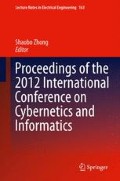Abstract
Using the approximate entropy method for sleep staging EEG signal, But to the sleep stage III and IV approximate entropy value is very close, So by the approximate entropy cannot be distinguished, the results of stage III and IV EEG signal AR modeling, as the EEG signal characteristic coefficient, use of Probabilistic neural network method and Relief algorithm to distinguished sleep stage III and IV, Relief algorithm achieve a good effect.
Access this chapter
Tax calculation will be finalised at checkout
Purchases are for personal use only
References
Rechtschaffen A, Kales A (1968) A manual of standardized terminology, techniques and scoring system for sleep stages of human subjects, vol 48. Government Printing Office, Public Health Service, Washington, DC, pp 3–7
Liang Xiaohua (2008) Based on EEG ECG data fusion of the sleep stages. Jiangsu University 428:281–291
Liu Hui, He Weixing, Chen Xiaoping (2005) Sleep EEG nonlinear dynamics method. J Jiangsu Univ Nat Sci Edn 26(2):174–177
Xiao Yuliang, He Weixing, Chen Xiaoping (2009) Based on the sample entropy sleep EEG staging. J Jiangsu Univ Nat Sci Edn 30(5):501–504
Ong RJ, Dawley JT, Clem PG (2006) Submitted to Journal of Materials Research (2003) Xiao YL, He WX, Chen XP, et al. Wavelet transform and wavelet entropy in the sleep EEG signal change characteristics of value. Chin J Clin Rehab 10(25):118–120
Chen Weiting, Wang Zhizhong, Xie Hongbo et al (2007) Characterization of surface EMG signal based on fuzzy entropy. IEEE Trans Neural Syst Rehab Eng 15(2):267–272
Pedro P, Pavel G, Leticia A (2004) Sleep stage classification using fuzzy sets and machine learning techniques. Neurocomputing 58:1137–1143
Ventours EM, Monoyiou EA, Ktonas PY et al (2005) Sleep spindle detection using artificial neural networks trained with filtered time-domain EEG: a feasibility study. Comput Methods Programs Biomed 78(3):191–207
Liu Jianping, Zheng Chongxun (1995) Analysis of EEG signals, an exploring brain function state and activity patterns of the way. Foreign Med Sci Biomed Eng Fascicle 18(5):263–270
Zhang Jie, Wang Ming (1997) The sleep EEG studies. Foreign Med Sci Biomed Eng 20(2):87–94
Fu Xiaohua, Li Hongpei (2003) Sleep and health. China J Med 38(8):34–42
Kira K, Rendell L (1992) A practical approach to feature selection. In: Proceedings of the 9th international workshop on machine learning. Morgan Kaufmann, San Francisco 34:249–256
Kononenkl I (1994) Estimation attributes: analysis and extensions of RELIEF. European conference on machine learning, vol 42. Springer Verlag, Catania, pp 171–182
Acknowledgement
This work was supported by Shaanxi Provincial Department of Education Special research projects (11JK0480), Shaanxi nature science foundation research programs (2011JM1010) and WeiNan Teachers University key research projects (11YKF011).
Author information
Authors and Affiliations
Corresponding author
Editor information
Editors and Affiliations
Rights and permissions
Copyright information
© 2014 Springer Science+Business Media New York
About this paper
Cite this paper
Jia, H. (2014). Sleep EEG Staging Studies Based on Relief Algorithm. In: Zhong, S. (eds) Proceedings of the 2012 International Conference on Cybernetics and Informatics. Lecture Notes in Electrical Engineering, vol 163. Springer, New York, NY. https://doi.org/10.1007/978-1-4614-3872-4_121
Download citation
DOI: https://doi.org/10.1007/978-1-4614-3872-4_121
Published:
Publisher Name: Springer, New York, NY
Print ISBN: 978-1-4614-3871-7
Online ISBN: 978-1-4614-3872-4
eBook Packages: EngineeringEngineering (R0)

